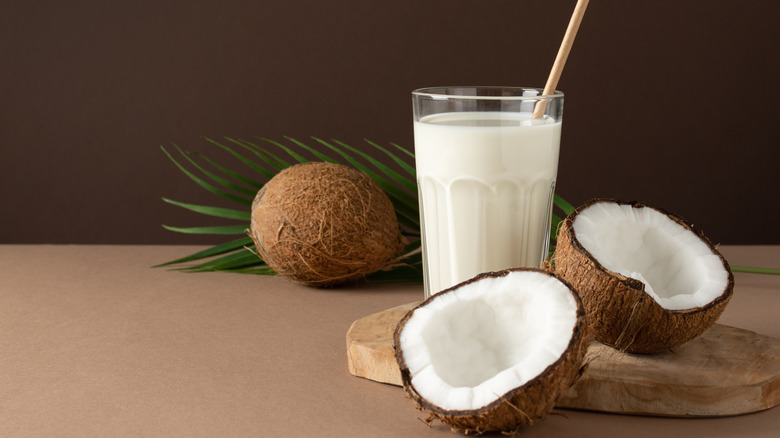The Ratio To Know When Substituting With Coconut Milk In Baking
Nowadays, dairy allergies and lactose intolerances won't leave you sitting on the sidelines when it comes to enjoying a yummy dessert. Plant-based milk can be used as a substitute for dairy milk in countless recipes, and in many cases, you'd be hard-pressed to tell the difference. One such dairy alternative is coconut milk, which Eater explains is essentially the liquid squeezed out from the white, fleshy part of the interior of a coconut. Not to be confused with coconut water, a clear liquid also contained within the fruit, coconut milk is white and fatty. You can find it sold in cans or cartons and should ideally look for a brand that doesn't include added sugars or stabilizers in the ingredients list.
There are many reasons to use coconut milk as a dairy substitute as opposed to other plant-based milk that goes beyond the delicious yet subtle coconut flavor it imbues into baked goods. Medical News Today points out that the product contains an antioxidant known as lauric acid that is great for heart health. Lauric acid also keeps infections at bay with its antimicrobial and anti-inflammatory nature. Additionally, coconut milk contains several essential vitamins and minerals, including vitamin C, potassium, calcium, and iron. If you're ready to give coconut milk a shot in your baking, it's important to be aware of the ratio to use to ensure a seamless substitution.
The coconut milk substitution ratio is a no-brainer
Luckily, it won't take any advanced mathematical calculations to sub in coconut milk for dairy the next time you bake. The substitution ratio is a simple 1:1, reports Real Simple. This means that if a recipe calls for 1 cup of dairy milk, you'll use 1 cup of coconut milk instead.
While this is as easy as it gets, there's an important caveat to using coconut milk that will affect how your baked good comes out. Some recipes may require different types of milk — i.e., heavy cream, whole milk, skim milk, etc. For a recipe calling for a higher fat content, you'll want to avoid shaking the can or carton before opening it. This ensures that the fatty layer of cream stays at the top of the container, allowing you to remove it and achieve a thicker result. The thinner, more liquid portion underneath the layer of cream can be used in recipes that require low-fat milk.
The Kitchn offers some additional tips for using coconut milk in baked goods. For starters, you'll want to pay attention to the label when purchasing the product. Ideally, you should opt for an unsweetened version to allow more wiggle room when concocting your dessert. Remember: You can always add more sugar. You'll also want to avoid buying coconut cream for a simple milk substitution as it is thicker, which will alter the taste and texture of the final product.

